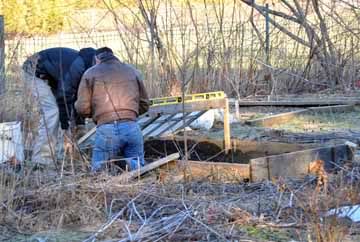Harvest Monday 3/21/2011
We were enjoying a few Spring like days here in the Mohawk Valley.
Walt and I have been talking about 'extending the season'... using gardening techniques to plant earlier than you would for your zone and conditions and harvesting food much later than you normally would of. Our first steps to accomplishing this is to build a cold frame. Walt scrounged around the homestead for materials. We had some old farmhouse windows we had stacked in the garage. Walt also found some used lumber and particle board. Our only expenses were hinges we bought at at Lowe's. So now I have a new cold frame that cost us about $10.


The cold frame was placed on a raised bed that sits over a concrete pad. This was the site of my grandfathers outdoor fireplace. The concrete was too thick to break up so we built a raised bed over it. The only drawback is that only plants with a shallow root system can be planted there. That still leaves me with lots of options. spinach, lettuce, scallions, parsley, endive. arugala maybe even small cabbages and swiss chard.
While Walt with some help from David was building the cold-frame, I prepared the soil removing the weeds and plants growing there from a few years of neglect. I pulled out two white buckets of quack grass roots and other weeds that I don't want in the compost pile. I also was able to pull out 4 pounds of Jerusalem Artichoke tubers and 3/4 pounds of Horseradish roots. So almost 5 pounds of food for our 1st harvest of the season.
I gave about half of the horseradish to my next door neighbor and grated some of the remainder to enjoy with the ham for dinner. Horseradish is easy to make. Cut as many roots as you want to use into 1 inch pieces. Pop into a blender with a little white vinegar (apple cider vinegar is OK too). Blend it until the root is grated up fine. Add more vinegar if needed to easily grate. Be careful about opening the blender jar. I suggest doing it outside. Fresh horseradish is more potent that the bottles you buy at the store.
Jerusalem Artichoke is not a well known vegetable. It is some time sold in grocery store produce aisles as "sun chokes". Jerusalem Artichoke is not an artichoke - not even related. But it is a delicious "wild edible plant". The tubers taste like a cross between carrot and potatoes and can be eaten raw, boiled, baked or steamed. I even read about dehydrating slices of the tubers and grinding it into flour. Jerusalem Artichoke, unlike white potatoes are very good for diabetics.


Comments
I've wanted to try sun chokes, but I've heard they are invasive so you need to plant them where you wouldn't mine them growing (and expanding!) Maybe this will be the year.
Happy spring!